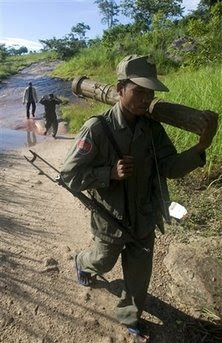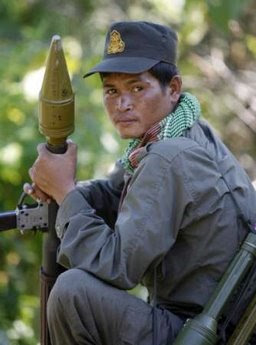By THE NATION
Published on July 21, 2008
The Democrat Party yesterday issued an open letter to the supreme commander urging him to negotiate not only military affairs but "bring to a conclusion" the question of sovereignty of the 4.6 square kilometres overlapping zone near Preah Vihear temple.
Supreme Commander General Bunsang Niampradit will lead a government delegation to negotiate with Cambodia over the Preah Vihear dispute today in the Joint Boundary Commission Between Thailand and Cambodia (JBC) meeting.
The move came after military tension rose with a confrontation at the Thai-Cambodia border.
Published on July 21, 2008
The Democrat Party yesterday issued an open letter to the supreme commander urging him to negotiate not only military affairs but "bring to a conclusion" the question of sovereignty of the 4.6 square kilometres overlapping zone near Preah Vihear temple.
Supreme Commander General Bunsang Niampradit will lead a government delegation to negotiate with Cambodia over the Preah Vihear dispute today in the Joint Boundary Commission Between Thailand and Cambodia (JBC) meeting.
The move came after military tension rose with a confrontation at the Thai-Cambodia border.
Some 60 shop owners have been ordered by the army to remove their goods and leave their shops around Preah Vihear.
In the letter, the Democrats shadow justice minister Peeraphan Saleeratwipak urged Bunsang to focus on negotiations in four areas:
lWhy the barbed wire that Thailand used to demarcate the area around Preah Vihear since 1962 had been moved and when would it be put back in its original position?
lWhy only Cambodian had been allowed to live in the overlapping zone agreed by the two countries since 1962?
lThailand has protested to Cambodia four times but had been ignored each time. Instead it sent more troops and people to live in the buffer zone. Thailand regards the buffer zone as belonging to Thailand in accordance with the treaty ratified between Thailand and France in 1904 and 1907.
Thailand has the right to push back Cambodian soldiers and people from this area.
Bansang should produce results about when the Cambodians will leave this area.
lHow are Cambodian soldiers and civilians able to easily cross the border and transport supplies and weapons to the overlapping zone? Should immigration procedures be made stricter?
The letter said Cambodia has been taking advantage of the situation to seize sovereignty of the buffer zone. They had filed the petition to the United Nation to mislead the international community into thinking Thailand had violated Cambodia's rights.
This may indicate Cambodia is not sincere over the dispute and Thailand should be aware of these incidents.
Meanwhile Deputy Government spokesman Nattawut Saikua said Prime Minister Samak Sundaravej had asked the Foreign Ministry and security agencies to forge an understanding with the UN and Cambodia over the dispute.
The government called on people who are not involved to stop any action that would add fuel to the fire.
"The problem has been worsening because some groups of people have tried to incite public sentiment by misleading them that the country has lost sovereignty to Cambodia, even though this is not true. They must stop doing that,'' he said.
Meanwhile, a high-ranking Cambodian military official yesterday inspected a hotel in Sa Kaeo where the JBC meeting is to be held. There was concern the People's Alliance for Democracy may stage a protest to disrupt the meeting.
Lt General Sok Piab, chief Thailand-Cambodia border co-ordinator led a military team to inspect the Indochina Hotel in Aranyaprathet District where Cambodian Deputy Prime Minister and Defence Minister General Tea Ban would meet with Supreme Commander General Bunsang Niempradit over the buffer zone dispute.
Meanwhile, Sa Kaeo Provincial Governor Surapol Pongtadsirikul and Burapha Task Force commander Maj General Walit Rojanapakdi and Sa Kaeo Provincial Police chief Pol Maj General Ithipol Piriyapinyo met to draw up a security plan to ensure a smooth meeting today. The team also inspected the Indochina Hotel.






















 Photos of the Preah Vihear site and drawings of the sanctuary which appear in Cambodia's nomination document for the listing of the ancient temple as the World Heritage site.
Photos of the Preah Vihear site and drawings of the sanctuary which appear in Cambodia's nomination document for the listing of the ancient temple as the World Heritage site.









